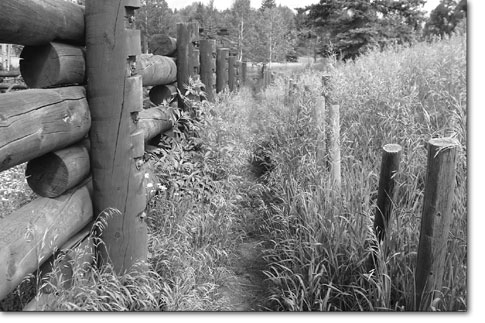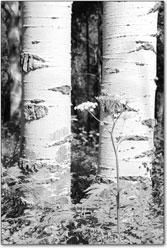|
|
||||
|
Using fire as a forest tool
by Will Sands The call, “let it burn,” is currently sounding throughout the Southwest. A recent review has uncovered major cost overruns tied to thinning forests and fighting catastrophic fires. In response, a conservation group has kicked off a push to expand use of deliberate fire as a forest management tool. The Forest Service currently has two ways of using fire for benefit– prescribed burns and wildland fire use. In a prescribed burn, the agency will identify an overgrown area that would benefit from a low-intensity fire and actually lights the match. With wildland-use fires, lightning triggers the blaze, but it is allowed to burn as long as it poses no immediate danger. Both tactics honor the natural cycle and help prevent fuel buildup that leads to instances like the catastrophic Missionary Ridge Fire of 2002. The Santa Fe-based conservation group, Forest Guardians, recently announced a campaign to expand these uses of fire on the forests of the Southwest. The move is meant not only to avert situations like the Missionary Ridge Fire, but to end the excessive expense of suppressing and fighting wildfire, according to Bryan Bird, an ecologist with the group. “The Forest Service needs to get serious about fire as a cost-efficient and ecologically superior management tool,” he said. Forest Guardians recently conducted a comprehensive review of Fire Management Plans and fuel management practices by the Forest Service in New Mexico and Arizona. The findings showed that the agency spends an average of $99 million per year to suppress wildfires in the two states. In those cases, the Forest Service has almost categorically refused the use of wildland fire. “Nearly every forest is failing to use fire as a tool and still spends hundreds of millions of dollars on unnecessary fire suppression and needless forest thinning,” said Bird. This reliance on fighting fires and thinning overgrowth also carries a heavy environmental price, according to Bird. While moderate fire is not very damaging and actually aids natural processes, hand thinning and hydromowing leave significant footprints. “Fire is economically much more efficient for managing fuels,” Bird said. “It can also be much less damaging to the environment than going in with heavy equipment. That can have an irreversible impact on water quality and soils.” Bird explained that fear is the primary reason the Forest Service is less inclined to rely on prescribed burns and wildland fire use. Specifically, the public has yet to embrace smoky skies and potential threats to life and property. “Fire’s not being used as much as it should be,” Bird said. “Much of that is a public perception problem. Many members of the public don’t want to have smoky skies during the summer. But many people are also realizing that’s part of living in the West.”
“Fire’s not being used as much as it should be,” Bird said. “Much of that is a public perception problem. Many members of the public don’t want to have smoky skies during the summer. But many people are also realizing that’s part of living in the West.” Bird acknowledged that the San Juan National Forest is more ahead of the times than forests in New Mexico and4 Arizona. However, he also suggested that more can be done “I think people in Southern Colorado are beginning to understand the realities of fire and its place in overall forest health,” Bird said. “I know the San Juan National Forest is using fire to some degree, and we’d like to encourage the expansion of that use.” An example of wildland fire use is still smoldering southeast of Pagosa Springs. Over the last four weeks, the Rio Blanco Fire grew from a small lightning-triggered blaze to a total of 1,200 acres. Although the agency was forced to stop the fire’s spread because of extremely dry weather, the wildland fire use was considered a success. “We had a pretty good experience with the Rio Blanco Fire,” said Pam Wilson, fire information officer. “We had some members of the public who understood what we were doing and were pleased with the outcome. We had others who did not and complained about the smoke.” For the most part, smoke and fire still elicit strong reactions in the Four Corners region, according to Wilson. Those reactions often hinder the forest when it comes to prescribed burning and wildland fire use. “People are still scared whenever they see smoke,” she said. In addition to public reaction, the agency has to consider a variety of parameters before allowing a lightning strike to spread. Threats to homes and property and the chance that the fire could get out of control are all potential hindrances to the forest management tool. “Each time we get a fire start, we look at it on a case-by-case basis,” Wilson said. “We’re only going to allow a wildland fire use if all the parameters are right.” The parameters all lined up for the Rio Blanco Fire. They did not for the Trail East Fire, which was sparked recently near Mancos. “People asked why we didn’t let the Trail East Fire go,” Wilson said. “But that fire could have burned all the way to the New Mexico border, and that didn’t seem like a good decision.” While talk of deliberate fire or allowing natural fires to spread still leads to ringing phones at the San Juan Public Lands Center, the public is coming up to speed. Courtesy of the 2002 wildfires, people are more aware of what happens when the forest is not actively managed and more apt to approve of prescribed fires and wildland fire use. “From the Forest Service side, I don’t think things have changed that much,” Wilson said. “From the public perspective, people are more aware of the problems our forests face. I think if they’re kept aware, they’ll usually accept what’s happening.” Like Bird and Forest Guardians, Wilson agreed that fire can be the most cost-efficient and biologically effective means of keeping the forest healthy. She noted that prescribed fire can cost one-tenth as much as hand thinning or hydromowing. The real savings come, however, when small, controlled fires take the place of large, devastating wildfires. “Suppressing fires for the last 100 years along with less logging and less grazing have gotten the forests into the conditions they’re in now,” Wilson said in closing. “The chances of having a devastating wildfire are a lot greater now than they used to be.” •
|
In this week's issue...
- May 15, 2025
- End of the trail
Despite tariff pause, Colorado bike company can’t hang on through supply chain chaos
- May 8, 2025
- Shared pain
Dismal trend highlights need to cut usage in Upper Basin, too
- April 24, 2025
- A tale of two bills
Nuclear gets all the hype, but optimizing infrastructure will have bigger impact



